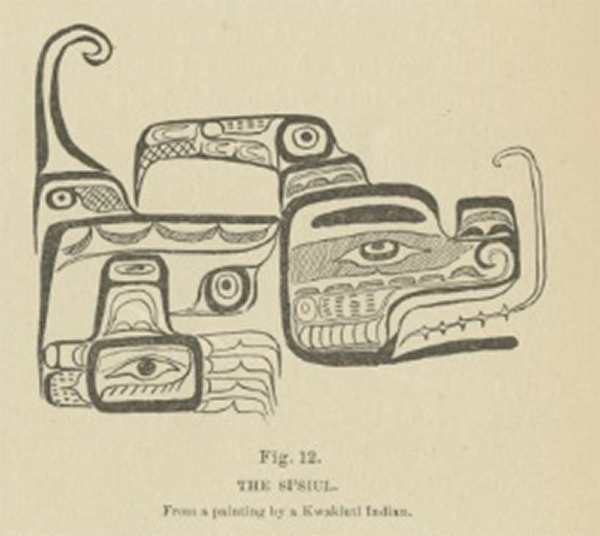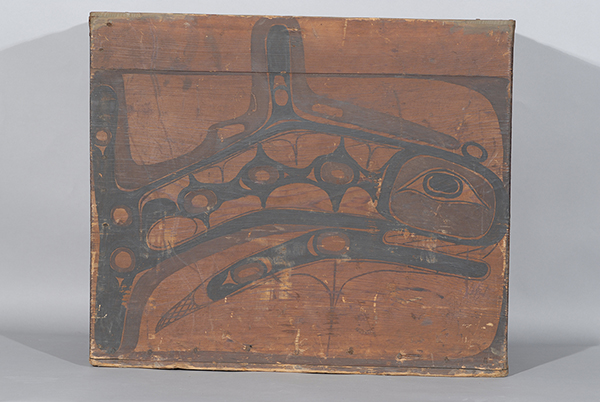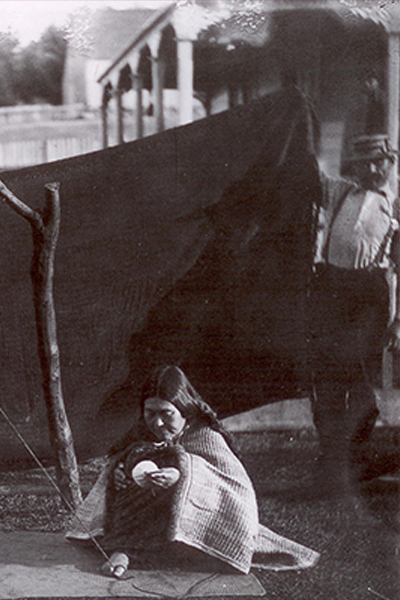CHAPTER VI: 1895-96 PREPARING THE BOOK
Drawing
Drawing
Attributed to Hiłamas/Chief Ned Harris, Kwakwaka’wakw, ca. 1895
Colored pencil, ink, and pencil on paper
6.5 x 10 in. (16.5 x 25.4 cm)
Collected by Franz Boas ca. 1895
Found in United States National Museum collection prior to 1969
National Anthropological Archives, Smithsonian Institution, 08533600

Figure 12 from Boas’s 1897 book.
The illustrations in Boas’s 1897 book derived mostly from field photography or drawings of objects in museum collections. Figure 12 is unique as it replicates a drawing he commissioned from a Kwakwaka’wakw artist. Boas had long solicited drawings from Native artists. For instance, in 1884 he asked Inuit consultants to draw maps for him.1 As part of the Jesup North Pacific Expedition, a large ethnographic collecting project in the North Pacific Coast, the Bering Strait, and Siberia from 1897 to 1902, Boas and his colleagues collected Native drawings of tattoos, masks, crests, house front designs, ceremonies and dances, and episodes from legends.2 Drawings provided Boas with data to analyze visual forms, prompts for eliciting stories, and the basis for published illustrations.
A large set of drawings in the collection of the American Museum of Natural History, stylistically similar to this one, are now attributed to ’Namgis artist Hiłamas (whose English name was Chief Ned Harris).3 These drawings depict Kwakwaka’wakw ceremonial scenes and crest motifs. A group of five utilize the same paper type (a slightly textured paper with bonded vertical lines) and stylus (slightly wider than a color pencil) as this example, suggesting they were drawn at the same time (AMNH Z/32a-e). Hiłamas drew another series of images on the back of pre-printed face templates that were likely produced for the Jesup expedition (AMNH Z/30a-p). A third set is on a smooth paper utilizing a thinner pencil (AMNH Z/31a-u). The use of different supports and pigments for distinct batches of drawings indicate a sustained relationship of artistic commissions between Boas, Hunt and Hiłamas.4 Boas published other drawings by Hiłamas throughout his career.5
This drawing depicts a half of a Sisiyutł, a powerful supernatural creature with two horned serpent heads and a horned human head. The book figure is captioned “one side of a drum,” suggesting the possible source object. The drums in question are constructed using the same technique as bentwood storage boxes but are narrower and open on one side for better acoustics (Fig. 1). In his drawing, Hiłamas fills the available space on the page as if it were the side of a drum. This distinctive use of space was lost, along with any significance in the coloring, when Boas had the motif redrawn in black ink in order to reproduce it in the book (Fig. 2).
Figure 1. Kwakwaka’wakw box drum collected by Johan Adrian Jacobsen, ca. 1881. Wood, paint. Courtesy of U’mista Cultural Centre and bpk Bildagentur / Ethnologisches Museum, Staatliche Museen, Berlin / Art Resource, NY.
Fig. 2. Drawing. Unknown maker, ca. 1896. Ink on paper. Commissioned by Franz Boas for reproduction in The Social Organization and the Secret Societies of the Kwakiutl Indians (fig. 12). National Anthropological Archives, Smithsonian Institution, Photo lot 82.
The original colored pencil drawing has four pinholes in its corners as if it has been pinned to a board, perhaps for research reference or to assist in copying it to ink for reproduction in The Social Organization. The drawing is annotated with Boas’s research notes, which enabled him to describe the Sisiyutł’s anatomical parts in his text.6 There are additional research and publication notes in a number of different hands, which have not yet been identified, indicating the drawing’s active use among a collaborative research and publication team.
By Amanda Thompson
PAGES IN THIS CHAPTER
- Cole, Franz Boas, 80.
- Glass, “Drawing on Museums,” 7.
- Attribution by Kwakwaka’wakw artist and researcher William Wasden Jr.. See Glass, Objects of Exchange, 195. For other drawings by Hiłamas, see AMNH collection numbers Z-30a-p, Z-31a-u, and Z-32a-i.
- An 1895 letter from George Hunt to Franz Boas reports that “our Painter Have got Half of the Book fild” (Hunt to Boas, 22 June 1895, APS). Although none of the known Hiłamas drawings appear to have been removed from a book, the letter’s 1895 date indicates that Hunt could be referring to Hiłamas. Boas and Hunt would have collected Hiłamas’s Sisiyutł drawing in the years directly preceding the 1897 publication of Social Organization.
- For other drawings by Hiłamas, see Boas, “The Decorative Arts,” Primitive Art, and Kwakiutl Ethnography.
- Boas, The Social Organization, 372.







